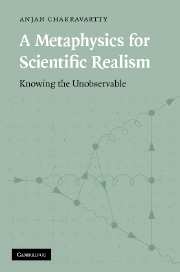Book contents
- Frontmatter
- Dedication
- Contents
- Tables
- Figures
- Preface
- Abbreviations
- Part I Scientific realism today
- Chapter 1 Realism and antirealism; metaphysics and empiricism
- Chapter 2 Selective scepticism: entity realism, structural realism, semirealism
- Chapter 3 Properties, particulars, and concrete structures
- Part II Metaphysical foundations
- Part III Theory meets world
- References
- Index
Chapter 3 - Properties, particulars, and concrete structures
Published online by Cambridge University Press: 22 September 2009
- Frontmatter
- Dedication
- Contents
- Tables
- Figures
- Preface
- Abbreviations
- Part I Scientific realism today
- Chapter 1 Realism and antirealism; metaphysics and empiricism
- Chapter 2 Selective scepticism: entity realism, structural realism, semirealism
- Chapter 3 Properties, particulars, and concrete structures
- Part II Metaphysical foundations
- Part III Theory meets world
- References
- Index
Summary
Inventory: what realists know
Entity realism (ER) and epistemic structural realism (epistemic SR) are proposals for realist humility. They offer to distinguish parts of scientific theories that are good bets for knowledge from others that are less so, thus allowing the realist to come to grips with the fact that accepted theories change over time. Neither ER nor epistemic SR, however, is humble in quite the right way. Their prescriptions for how realists ought to be selective sceptics are problematic and ultimately, I believe, untenable. As steps in the evolution of realism, however, they are on the right track, and I have aimed to incorporate the best insights of both under the heading of ‘semirealism’.
The lesson of ER concerns the epistemic basis of claims about unobservables. By emphasizing causation, ER captures the common and deeply held realist intuition that the greater the extent to which one seems able to interact with something – at best, manipulating it so as to bring about desired outcomes – the greater the warrant for one's belief in it. But ER attempts to separate a knowledge of entities from a knowledge of their relations, and this cannot be done. It also gives encouragement to awkward diagnoses of historical events. Imagine a review of the evidence considered by different physicists, over time, for thinking they had detected a negative charge.
- Type
- Chapter
- Information
- A Metaphysics for Scientific RealismKnowing the Unobservable, pp. 58 - 86Publisher: Cambridge University PressPrint publication year: 2007



